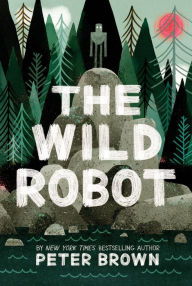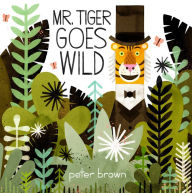An Interview with The Wild Robot Author Peter Brown
The Wild Robot (Wild Robot Series #1)
The Wild Robot (Wild Robot Series #1)
By Peter Brown
In Stock Online
Hardcover $16.99
Peter Brown is the bestselling, award-winning author and illustrator of over a dozen books. (Fourteen, to be exact!) Somehow, while in the midst of creating awesome picture books like Mr. Tiger Goes Wild and You Will Be My Friend!, he decided to write a middle grade novel as well. And readers, be glad he did. The Wild Robot is quite simply, fantastic. It retains the poetry of a picture book but with depth of a longer read. The Wild Robot is the story of a robot named Roz who wakes up and finds herself alone on an island. How did she get there? What is her purpose? And what happens when nature and technology collide? The B&N Kids Blog got Peter to step away from the drawing (and writing) table and answer a few questions about writing, robots, bowerbirds, and a lot of other cool stuff.
Where did the idea for The Wild Robot come from?
Years ago, while working on a picture book called The Curious Garden, I spent a lot of time drawing scenes of plants living in industrial settings. I pushed myself to imagine all the ways nature might possibly coexist with technology. And at one point I drew a picture of a robot in a tree. Suddenly, my imagination was flooded with ideas for a story about a robot finding harmony in the wilderness. I didn’t realize at the time that I’d stumbled upon the premise for my first children’s novel.
Peter Brown is the bestselling, award-winning author and illustrator of over a dozen books. (Fourteen, to be exact!) Somehow, while in the midst of creating awesome picture books like Mr. Tiger Goes Wild and You Will Be My Friend!, he decided to write a middle grade novel as well. And readers, be glad he did. The Wild Robot is quite simply, fantastic. It retains the poetry of a picture book but with depth of a longer read. The Wild Robot is the story of a robot named Roz who wakes up and finds herself alone on an island. How did she get there? What is her purpose? And what happens when nature and technology collide? The B&N Kids Blog got Peter to step away from the drawing (and writing) table and answer a few questions about writing, robots, bowerbirds, and a lot of other cool stuff.
Where did the idea for The Wild Robot come from?
Years ago, while working on a picture book called The Curious Garden, I spent a lot of time drawing scenes of plants living in industrial settings. I pushed myself to imagine all the ways nature might possibly coexist with technology. And at one point I drew a picture of a robot in a tree. Suddenly, my imagination was flooded with ideas for a story about a robot finding harmony in the wilderness. I didn’t realize at the time that I’d stumbled upon the premise for my first children’s novel.
The Curious Garden
The Curious Garden
By Peter Brown
In Stock Online
Hardcover $18.99
As you generally write picture books, why did you think this story would be best told as a middle grade book?
My goal for this story was to show, step-by-step, how a robot gradually becomes part of the wilderness. I knew the story would require a lot of research, and careful planning, and far more words than I could fit into a picture book. The Wild Robot had to be a novel. And middle grade readers, with their combination of curiosity and imagination and knowledge, seemed like the perfect audience.
There are so many great animal characters (otters, opossums, geese!) who make an appearance. Did you do a lot of wildlife research? And do you have any fun facts from the natural world that you can share?
I spent years doing research for this book. And in the process, I learned some really interesting facts about nature, like how bowerbirds build elaborate structures out of twigs that they decorate with flowers and berries and sometimes even living insects. I’d hoped to fill my story with those kinds of details, but things got so complicated that I had to simplify. One way of simplifying was to take advantage of what children already know. Children know that beavers build dams, and geese migrate, and opossums play dead. I could mention those kinds of interesting behaviors to the reader without having to explain them, and that allowed me to focus on delicate aspects of the story, like Roz’s relationship with her adopted gosling son.
As you generally write picture books, why did you think this story would be best told as a middle grade book?
My goal for this story was to show, step-by-step, how a robot gradually becomes part of the wilderness. I knew the story would require a lot of research, and careful planning, and far more words than I could fit into a picture book. The Wild Robot had to be a novel. And middle grade readers, with their combination of curiosity and imagination and knowledge, seemed like the perfect audience.
There are so many great animal characters (otters, opossums, geese!) who make an appearance. Did you do a lot of wildlife research? And do you have any fun facts from the natural world that you can share?
I spent years doing research for this book. And in the process, I learned some really interesting facts about nature, like how bowerbirds build elaborate structures out of twigs that they decorate with flowers and berries and sometimes even living insects. I’d hoped to fill my story with those kinds of details, but things got so complicated that I had to simplify. One way of simplifying was to take advantage of what children already know. Children know that beavers build dams, and geese migrate, and opossums play dead. I could mention those kinds of interesting behaviors to the reader without having to explain them, and that allowed me to focus on delicate aspects of the story, like Roz’s relationship with her adopted gosling son.
Children Make Terrible Pets
Children Make Terrible Pets
By
Peter Brown
Illustrator
Peter Brown
In Stock Online
Hardcover $17.99
The illustrations, which are frequently integrated throughout the book are, not surprisingly, perfect. And such a treat in a middle grade read! What comes first for you, the images or words?
In the case of The Wild Robot, I drew a picture of a robot in a tree, which set the whole story in motion. But every book is different. Sometimes it’s a simple sentence that inspires a story, which is what happened with Children Make Terrible Pets. Other times I might visit a real place that inspires a series of drawings that eventually lead to a story, which is what happened with The Curious Garden. Being an author and illustrator means I can bounce between writing and illustrating and follow my inspiration wherever it takes me.
What has been the most fun or surprising part of writing for this age group?
This might sound crazy, but I really enjoyed writing a story with a sad ending. Well, the ending is slightly sad, anyway. Until now, I’ve only written picture books, which usually have happy endings. But the real world is complicated, and it was incredibly satisfying to write a story that feels true to life. I think middle grade readers appreciate that kind of honesty in the stories they read.
The illustrations, which are frequently integrated throughout the book are, not surprisingly, perfect. And such a treat in a middle grade read! What comes first for you, the images or words?
In the case of The Wild Robot, I drew a picture of a robot in a tree, which set the whole story in motion. But every book is different. Sometimes it’s a simple sentence that inspires a story, which is what happened with Children Make Terrible Pets. Other times I might visit a real place that inspires a series of drawings that eventually lead to a story, which is what happened with The Curious Garden. Being an author and illustrator means I can bounce between writing and illustrating and follow my inspiration wherever it takes me.
What has been the most fun or surprising part of writing for this age group?
This might sound crazy, but I really enjoyed writing a story with a sad ending. Well, the ending is slightly sad, anyway. Until now, I’ve only written picture books, which usually have happy endings. But the real world is complicated, and it was incredibly satisfying to write a story that feels true to life. I think middle grade readers appreciate that kind of honesty in the stories they read.
Mr. Tiger Goes Wild
Mr. Tiger Goes Wild
By Peter Brown
In Stock Online
Hardcover $18.00
I found myself having a surprising amount of empathy for Roz the robot. How do you feel about technology? And why did you decide to give her a gender?
One of the greatest things about reading is that it develops our sense of empathy, and we find ourselves caring about characters that are completely unlike us. I’m hoping this will be true even when the character is a robot. But just in case, I took some precautions to help readers relate to Roz. For example, robots can take almost any shape, but I gave Roz arms and legs and a head, so readers can more easily imagine themselves in her shoes. Also, I made Roz an outsider trying to fit in to a new community, which is an experience most people have at some point. And I decided to give Roz a gender so I wouldn’t have to refer to her with the pronoun “it.” It’s hard to relate to an “it.” I examined her personality, and the way others saw her, and I decided Roz would be “female.”
What’s next for you? Can we look forward to more Wild Robot books?
I’m currently dreaming up another story for Roz. And of course I’ll be making many more picture books. The next few years of my life are going to be very busy. I’m exhausted just thinking about it.
The Wild Robot is in stores now!
I found myself having a surprising amount of empathy for Roz the robot. How do you feel about technology? And why did you decide to give her a gender?
One of the greatest things about reading is that it develops our sense of empathy, and we find ourselves caring about characters that are completely unlike us. I’m hoping this will be true even when the character is a robot. But just in case, I took some precautions to help readers relate to Roz. For example, robots can take almost any shape, but I gave Roz arms and legs and a head, so readers can more easily imagine themselves in her shoes. Also, I made Roz an outsider trying to fit in to a new community, which is an experience most people have at some point. And I decided to give Roz a gender so I wouldn’t have to refer to her with the pronoun “it.” It’s hard to relate to an “it.” I examined her personality, and the way others saw her, and I decided Roz would be “female.”
What’s next for you? Can we look forward to more Wild Robot books?
I’m currently dreaming up another story for Roz. And of course I’ll be making many more picture books. The next few years of my life are going to be very busy. I’m exhausted just thinking about it.
The Wild Robot is in stores now!



